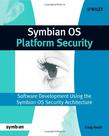Symbian 操作系统平台安全指南 Symbian OS Platform Security
出版时间:2006-4 出版社:John Wiley & Sons Inc 作者:Heath, Craig 页数:249
Tag标签:无
内容概要
Symbian OS is an advanced, customizable operating system, which is licensed by the world's leading mobile phone manufacturers. The latest versions incorporate an enhanced security architecture designed to protect the interests of consumers, network operators and software developers. The new security architecture of Symbian OS v9 is relevant to all security practitioners and will influence the decisions made by every developer that uses Symbian OS in the creation of devices or add-on applications. Symbian OS Platform Security covers the essential concepts and presents the security features with accompanying code examples. This introductory book highlights and explains: * the benefits of platform security on mobile devices * key concepts that underlie the architecture, such as the core principles of 'trust', 'capability' and data 'caging' * how to develop on a secure platform using real-world examples * an effective approach to writing secure applications, servers and plug-ins, using real-world examples * how to receive the full benefit of sharing data safely between applications * the importance of application certification and signing from the industry 'gatekeepers' of platform security * a market-oriented discussion of possible future developments in the field of mobile device security
书籍目录
About This Book. Foreword. About the Authors. Author’s Acknowledgements. Symbian Press Acknowledgements. Part 1 Introduction to Symbian OS Platform Security. 1 Why a Secure Platform? 1.1 User Expectations of Mobile Phone Security. 1.2 What the Security Architecture Should Provide. 1.3 Challenges and Threats to Mobile Phone Security. 1.4 How Symbian OS Platform Security Fits into the Value Chain. 1.5 How Application Developers Benefit from the Security Architecture. 2 Platform Security Concepts. 2.1 Background Security Principles. 2.2 Architectural Goals. 2.3 Concept 1: The Process is the Unit of Trust. 2.4 Concept 2: Capabilities Determine Privilege. 2.5 Concept 3: Data Caging for File Access. 2.6 Summary. viii CONTENTS Part 2 Application Development for Platform Security. 3 The Platform Security Environment. 3.1 Building Your Application. 3.2 Developing on the Emulator. 3.3 Packaging Your Application. 3.4 Testing on Mobile Phone Hardware. 3.5 Summary. 4 How to Write Secure Applications. 4.1 What Is a Secure Application? 4.2 Analyzing the Threats. 4.3 What Countermeasures Can Be Taken? 4.4 Implementation Considerations. 4.5 Summary. 5 How to Write Secure Servers. 5.1 What Is a Secure Server? 5.2 Server Threat Modeling. 5.3 Designing Server Security Measures. 5.4 Server Implementation Considerations. 5.5 Summary. 6 How to Write Secure Plug-ins. 6.1 What Is a Secure Plug-In? 6.2 Writing Secure Plug-ins. 6.3 Plug-in Implementation Considerations. 6.4 Summary. 7 Sharing Data Safely. 7.1 Introduction to Sharing Data. 7.2 Categories of Data. 7.3 Deciding the Level of Trust. 7.4 Attacks on Data and Countermeasures. 7.5 Using System Services. 7.6 Summary. Part 3 Managing Platform Security Attributes. 8 Native Software Installer. 8.1 Introduction to the Native Software Installer. 8.2 Validating Capabilities. 8.3 Identifiers, Upgrades, Removals and Special Files. 8.4 SIS File Changes for Platform Security. 8.5 Installing to and from Removable Media. 8.6 Summary. 9 Enabling Platform Security. 9.1 Responsibilities in Granting Capabilities. 9.2 Overview of the Signing Process. 9.3 Step-by-step Guide to Signing. 9.4 Revocation. 9.5 Summary. Part 4 The Future of Mobile Device Security. 10 The Servant in Your Pocket. 10.1 Crystal-Ball Gazing. 10.2 Convergence, Content and Connectivity. 10.3 Enabling New Services. 10.4 New Security Technologies. 10.5 Summary. Appendix A Capability Descriptions. Appendix B Some Cryptography Basics. Appendix C The Software Install API. Glossary. References. Index.
图书封面
图书标签Tags
无
评论、评分、阅读与下载
Symbian 操作系统平台安全指南 Symbian OS Platform Security PDF格式下载
用户评论 (总计0条)
推荐图书
- 精读梁启超
- 世界上的奇迹
- 管理信息系统
- 现代癫癎学
- 临床癫癎学
- 神经科急症
- 现代企业制度
- 高考美术指南
- 2003硕士研究生入学考试英语复习指导(磁带上、下)
- 晓传书斋文史论集
- 劳伦斯文集
- 新世纪全国名牌大学附小应考能力测试与评估
- 世界名人传记 艺术家卷 全套四册 含盘
- 天然药物化学习题集
- 信息技术(小学2上)(拼音版) (平装)
- 二年级上-帮你学数学-新修订版-配合国家新课程标准
- 信息技术.小学三年级(下)
- 三年级上-帮你学数学-新修订版-配合国家新课程标准
- 信息技术.小学四年级(下)
- 新课标小学语文阅读训练
- 信息技术.小学六年级(下)
- 小学数学五年级(上)(人教版)-帮你学数学
- 小学语文五年级(上)(人教版)-伴你学语文
- 信息技术.小学五年级(下)
- 帮你学语文-小学语文一年级(上)(人教版)
相关图书
- 智能手机操作系统及Symbian操作系统辅导手册 Smartphone Operating System
- PROTEUS入门实用教程
- Delphi数据库开发及精彩实例
- BlackBerry Pearl指南 BlackBerry Pearl For Dummies
- 精准傻瓜书 Lean For Dummies
- Maya 游戏动画指南
- 网络傻瓜书 Networking For Dummies
- Linux 家庭网络傻瓜书
- Photoshop通道与遮罩宝典 Photoshop CS3 Channels and Masks Bible
- 简捷计算机转移与备份 Simple Computer Transfer and Backup
- Wrox Visual C# 2005速成版入门技巧 Wrox's Visual C# 2005 Express Edition Starter Kit
- MythTV 揭秘 Hacking MythTV
- Mac mini改装傻瓜书 Mac mini Hacks & Mods For Dummies
- 自学无线网络 Teach Yourself VISUALLY Wireless Networking
- 网络路由基础
- Oracle PL/SQL 手册 Oracle PL/SQL For Dummies
- 专家SQL Server 2005 CLR 编程
- 灾难应对与恢复 Wiley Pathways Disaster Response and Recovery
- 一年生植物与多年生植物大全
- 商业银行经营管理
- 初中同步测控优化训练(下)
- 老年呼吸病
- PHP程序开发范例宝典
- 精读康有为
- 精读金岳霖
